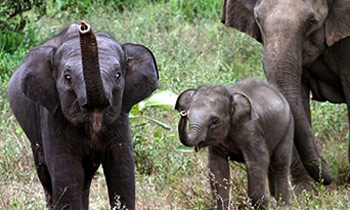
SL animal activists stop elephant flying to New Zealand
A Sri Lankan baby elephant gifted to New Zealand has been prevented from leaving the South Asian island after animal activists said it was cruel to separate her from her family.
Six-year-old Nandi was bequeathed to former New Zealand Prime Minister John Key by President Maithripala Sirisena at a meeting in Colombo in February 2016 to mark ‘excellent bilateral relations’ between the two countries. New Zealand vets had visited Sri Lanka last year to prepare Nandi for the journey to Auckland Zoo.
But animal rights activists have since intervened, arguing against moving the elephant to a foreign country where she will likely find it difficult to be separated from her family and adapt to the new climate.
The group of 18 secured a temporary victory Friday when a Sri Lankan court was assured by the state that Nandi would not be flown out of the country pending a final decision on the case next month.
‘Sri Lankan elephants have very strong family ties and to take away a child is a sin,’ Omalpe Sobitha, a Buddhist monk and one of the activists, told AFP. He added that the animal may not be able to cope with the cold weather in Auckland, where mean annual temperatures of around 15 degrees Celsius (59 Fahrenheit) would come as a shock to a calf used to the tropical 27 degree average in Sri Lanka.
‘We have an assurance from the court yesterday (Friday) that Nandi will not be taken out of the country until the case is concluded’, he said. Born and raised in a 93-strong herd in a coconut grove at an orphanage in central Sri Lanka, Nandi is the second baby elephant to be presented to New Zealand in a year after a female baby ‘Anjalee’ was sent to Auckland Zoo in 2015.
Key told Sirisena at their meeting last February that Anjalee had gained 700 kilos (1,540 pounds) in one year and that it was ‘loving its life in New Zealand and I am sure its friend (Nandi) will have such a good time as well in New Zealand’. Sri Lanka has a long history of giving elephants as presents — China has been gifted three over the years, and two each for Japan, South Korea, the Czech Republic and the United States.(AFP)
Source – 02/04/2017, Dailymirror, See more at: http://www.dailymirror.lk/article/SL-animal-activists-stop-elephant-flying-to-New-Zealand-126604.html#sthash.AepWVVpG.dpuf
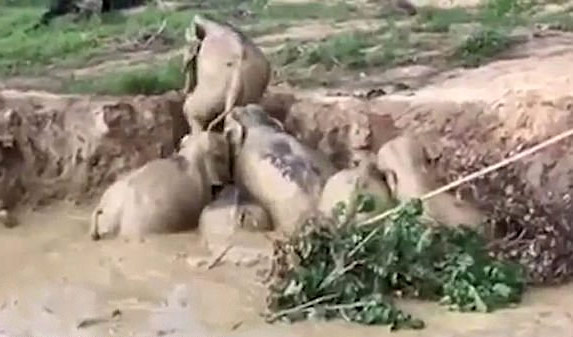
The great escape!
Eleven elephants have been saved from drowning after they were rescued from a flooded bomb crater after being stuck for four days. Environment workers said the elephants were discovered almost fully submerged on a wildlife reserve in Cambodia on Friday.
Word was then passed to wildlife agency WCS whose members arrived the following day to dig a channel up the side of the crater so the animals could climb out. The head of Cambodia’s environmental officer in eastern Mondulkiri province, said the animals had been trapped for three days before they were found.
They said the pack likely wandered into the 10ft deep hole in order to drink, but were then unable to get out again. Rescue workers had to dig out the side of the pit, which was created by a blast during the country’s bloody civil war, by hand. Water was also pumped into the pit to loosen the sludge and allow the huge animals to climb out safely.
Losing 11 elephants, including three calves, would have been a devastating blow to Cambodia’s wildlife. There are only thought to be a few hundred endangered Asian elephants left inside the country as populations fall due to habitat loss. (Daily Mail).
Source – 30/03/2017- , Dailymirror , See more at – http://www.dailymirror.lk/article/The-great-escape–126486.html

Kandy tops list in air pollution
By Niranjala Ariyawansha
The Central Environmental Authority (CEA) has said that an official scientific clarification will be given before the forthcoming New Year to claims that Kandy is Sri Lanka’s worst city in terms of air pollution.
Acting Deputy Director General, Environmental Pollution Control of CEA, Dr. Sanjaya Ratnayaka expressed these views to Ceylon Today when we inquired about the problem.
Retired Emeritus Professor, Science Faculty of Peradeniya University O. E. Illeperuma revealed that the people who live in Kandy City should wear masks because the air pollution in the city was four or five fold more when compared to Colombo City.
According to the data of the Road Development Authority (RDA) in 2015, about 417,000 vehicles enter and exit into Kandy on a daily basis.
However, Dr. Ratnayaka expressed a different view. “We have not reported such a thing. But it is good that the professor has highlighted the matter. For the moment, we cannot comment on Prof. Illeperuma’s report. The reason is we are yet to conduct a study on the matter.”
However, he pointed out that the CEA was the official authority of monitoring air pollution and they would take necessary measures within the next two weeks.
“We are having test runs on a Mobile Air Quality Monitoring Station in the CEA premises at this moment. We will check the accuracy of the station first. Then we can create a clear picture. After that we will move to monitor the air pollution level of Kandy City,” Dr. Ratnayaka said.
Prof. Illeperuma warned that the people who live and travel in cities could be affected by respiratory diseases and carcinogens.
Against this backdrop Dr. Ratnayake said that the CEA had already received the equipment to carry out the tests on air pollution.
He added that the air pollution tests in Kandy City will begin with the schools.
Meanwhile Chairman of the Urban Development Authority (UDA) Dr. Jagath Munasinghe said that the Kandy City Development Plan had been updated under the Japan International Cooperation Agency (JICA) fund to include solutions for the problem of air pollution.
He highlighted that both Prof. Illeperuma’s study and the Transport Study conducted by Prof. Amal Kumarage of the Moratuwa University conducted in 2010, would be considered in developing the Kandy City Development Plan.
He further pointed out that substandard constructions, water supply and traffic congestion would be among the other factors considered when developing the plan.
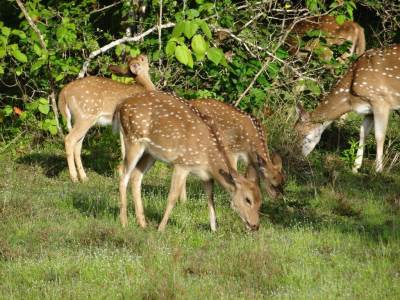
Kataragama’s Deer Slaughtered
D. N. Kaluarachchi – Kataragama
Hunters have killed eight of the herd of 9 deer in the Nagahaveediya Beheth Watta area near the Ruhunu Maha Kataragama Dewale.
Townsfolk say there were 17 in the herd not very long ago that was a familiar sight often emerging out from the scrub jungle to roam around in the sacred city where they had mixed at ease with the people. But several poachers had trapped many of them while at least two of the animals had been the victims of crocodiles in the Menik Ganga. The carcass of a deer which had been killed in Beheth Watte had been found in the forest recently.
Villagers here say the animals are killed in the shrub forest and stripped of their flesh to meet a huge demand for venison in tourist hotels. Although the authorities had been informed about these happenings through the media on several occasions, apathy on their part resulted in the deer not being taken for safety to the Yala Wildlife National Park. There’s now only a single deer, with antlers, and he too will disappear soon, they say.
Source 29/03/2017, Ceylon Today, See more at – http://www.ceylontoday.lk/article20170101CT20170331.php?id=4632

200-year-old Mara tree inside Galle Fort cut down
A 200-year-old ‘Mara’ tree inside the historic Dutch Fort in Galle has been cut down by authorities as it posed a risk to people’s lives.
The tree, dating back to the Dutch colonial period, was situated next to the Galle Court Complext inside the Fort. Workers from the State Timber Corporation cut it down on a request made by Galle Four Grevates Divisional Secretary.
The decision to cut down the historic tree was made as it was dead and was posing a risk to the court complex as well as to those traveling on the road next to it.
A Spokesman for the Galle Heritage Foundation stated that new Mara saplings will be planted at the spot where the tree was cut down, as well as several other identified locations within the Fort. He assured that measures are being taken to ensure that the historic nature of the Fort is protected.
Pix by Sirangika Lokukarawita
Source – 28/03/2017,Times Online, See more at – http://www.sundaytimes.lk/article/1019185/200-year-old-mara-tree-inside-galle-fort-cut-down
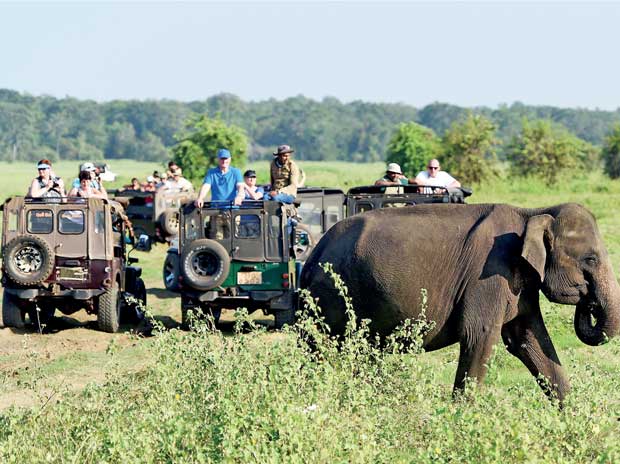
More tourism gains for SL
ourists watch a Sri Lankan elephant walk through a field in the Minneriya National Park. Sri Lanka earned US $ 3.52 billion from tourism in 2016 on the back of little over two million tourists visiting the country (AFP).
Source – 28/03/Dailymirror- See more at: http://www.dailymirror.lk/article/More-tourism-gains-for-SL-126298.html#sthash.V2hdq9Y8.dpuf
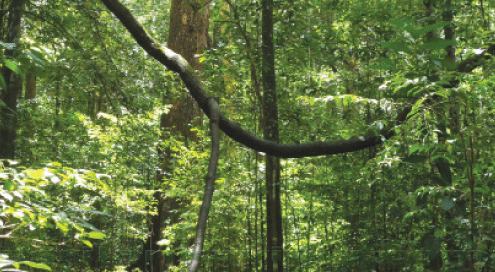
Six Forest reserves made one
All protected forest reservations that are situated to the North of the Wilpattu National Park and belonging to the Wildlife Department have been declared as one forest reservation by the government, informed sources said.
As a result of this declaration, the Mawillu, Veppal, Karadikkuly, Marichchakatti, Wilaththikulam and Periyamurippu reservations have now been joined and declared as ‘Mawillu Forest Reservation as per clause 3 A of the Wildlife Conservation Act.
The President’s media unit said that President Maithripala Sirisena signed a gazette notification to this effect during his ongoing tour of Russia yesterday.
Henceforth any change to the border of this new forest reservation can only be effected by the subject Minister and it has to be approved by the President before being ratified in Parliament and gazetted.
Sources said as per the new gazette notification the forest reservation will be further protected.
Source – 25/03/2017, Ceylon Today , See more at – http://www.ceylontoday.lk/article20170101CT20170331.php?id=4586
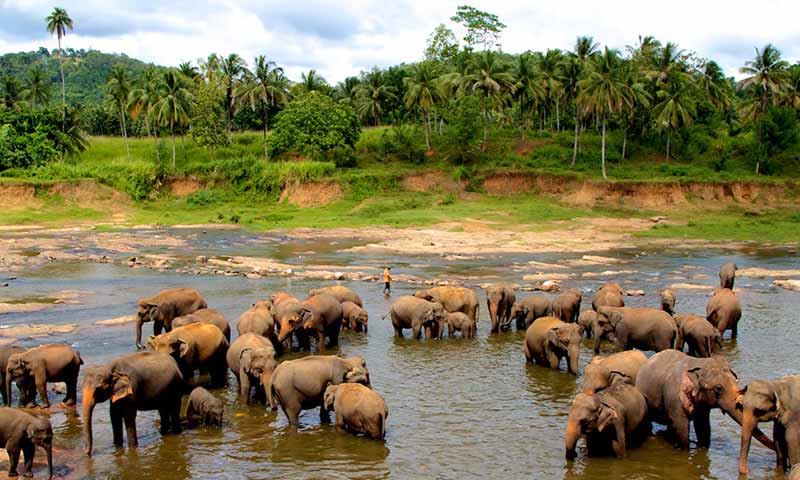
‘Hakkapatta’ found in Pinnawala
A few ‘hakkapatas’, a small handmade explosive device, were found hidden in a tree on the banks of Maa Oya, near the elephant bathing area in Pinnawala.
The Police suspect that they were hidden there to purposefully hurt the elephants while they were bathing. The person responsible for these is still unknown.
The explosives will be disposed of once the order comes from the Kegalle Courts. The Police are conducting investigations.
Source – 25/03/2017,Front page, See moreat – http://www.frontpage.lk/page/-Hakkapatta-found-in-Pinnawala/19655
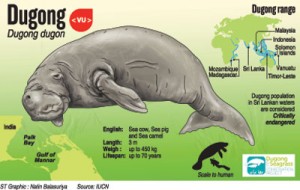
Threatened dugongs thrown a lifeline
The dugong is the most threatened marine mammal likely to disappear from our waters, but there are efforts to save the species.
Thirteen dugongs were killed last year, according an informal survey in the North Western coastal areas by marine activists. This is one dugong killed every month and considering their rarity, is worrying, says Prasanna Weerakkody of Ocean Resources Conservation Association.
“Through informal discussions with fishermen, we found out that one dugong had been trapped in a net. The fishermen knew it was illegal to pull it ashore and had it anchored under water to collect it when the navy is not around. But the carcass got loose and washed ashore,” revealed Weerakkody. There could be many other dugong deaths that go unreported, he said.The latest dugong deaths occurred December last year. A carcass was found on Nadukuda beach in Mannar. A few weeks earlier, another carcass washed ashore near Thavilpadu beach. Fishing activities using explosives are common in the nearby Vankalai Coral Reef and marine activists initially thought dynamite had killed the dugong found in Nadukuda.
Dugongs are also called mermaids of the sea because some sightings of mermaids are actually misidentified dugongs seen from afar
The dugong is also known as the ‘sea cow’ for its habit of grazing on the seagrasses on the ocean bed. Seagrass is different from seaweeds (which is an algae) and are actually more closely related to the flowering plants with roots, stems, leaves, flowers and seeds. Seagrasses can form dense underwater meadows and an adult dugong consumes as much as 45 kg seagrass according to experts.
Dugongs are vulnerable to extinction because they are killed directly or indirectly by human-related activities, which include fishing, coastal development and hunting. The seagrasses on which they depend are thought to be one of the most threatened ecosystems on Earth.
In 2015, the “Dugong and Seagrass Conservation Project” was initiated to improve protection and conservation of dugongs and their seagrass habitats around the world, said United Nation’s Environment Program (UNEP)’s Max Zieren who recently visited Sri Lanka. Indonesia, Madagascar, Malaysia, Mozambique, Solomon Islands, Sri Lanka, Timor Leste and Vanuatu is part of the project, which is the first coordinated effort, he added.
In Sri Lanka, the project focuses on the northwest region, namely the Gulf of Mannar and Palk Bay where dugongs have been recorded. The project is coordinated by the Department of Wildlife Conservation and eight other partner organisations are supporting.
Sugath Emmanuel, local fisherman and diver in Kalpitiya, said he had not seen a dugong alive. He recalled eating dugong flesh during his childhood, in an area where many dugongs were caught. The flesh was considered a local delicacy. Hundreds of dugongs were killed before it was outlawed in the 1970s. Now, about 90 percent of the dugong killings are accidental or by-catch. 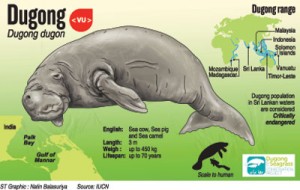
Dugongs are categorised as ‘vulnerable’ in IUCN’s threatened species list considering global populations, but they can be ‘critically endangered’ in Sri Lankan waters, says Arjan Rajasuriya, project manager of International Union of Conservation of Nature (IUCN). He has been diving for the past 30 years, but has yet to see a dugong alive.
IUCN’s responsibility in the project aims at establishing an additional 10,000 hectares of marine protected area in the Gulf of Mannar and Palk Bay. Rajasuriya says dynamite fishing should be halted.
The project also aims to raise awareness among people and also give incentives to abandon illegal fishing methods. Project partner, Sri Lanka Turtle Conservation Project, is seeking to reduce the negative impact of destructive fishing practices on seagrass habitats and provide income generation opportunities to local communities in return for their commitments for the prudent use of habitat and natural resources in the Puttlam lagoon.
The Biodiversity Education and Research NGO has taken on the education aspect of the project, especially targeting schools. Ranil Nanayakkara, who heads the group, says the response from school children has been positive.
The overall project is financed by Global Environment Fund Project and Mohamed bin Zayed Species Conservation Fund. The United Nations Environment Programme supports its implementation together with the Memorandum of Understanding on the Conservation and Management of Dugongs and their Habitats throughout their Range of the Convention on Migratory Species.
Dr Lakshman Peiris, who is the project manager of DWC, said the Wildlife Department was focused on addressing marine issues with the establishment of a special unit.
The Sunday Times also asked Peiris what will happen after the four-year project ends in 2018. “The project will give us lots of information. We will create a management plan and will make sure its implementation together with other strategic partners such as Department of Fisheries, Coast Conservation & Coastal Resources Management Department, and the Marine Environment Protection Authority. The Sri Lanka Navy and Sri Lanka Coast Guard can give us lots of support by monitoring and stopping illegal activities,’’ Peiris added.
Dugongs are also found in the Indian part of the Gulf of Mannar, but unfortunately India is not part of the project. Marine biologists say India too needs to get on board. Peiris of the DWC said plans are underway to increase coordination between two countries.
Marine biologists also stress the need for action, once a strategy to save the dugongs are made. “Since the dugong is a charismatic species, we can use activities geared to protecting it to also help us to provide a refuge for other threatened marine creatures,” marine expert Rajasuriya said.
Source – 26/03/2017, The Sunday Times, See more at – http://www.sundaytimes.lk/170326/news/threatened-dugongs-thrown-a-lifeline-234096.html
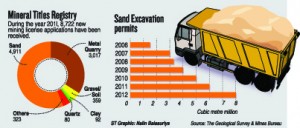
Building boom endangers sand and gravel resources
Sri Lanka’s lawmakers this week approved a proper mechanism to mine sand, gravel, and rocks from lands belonging to the Mahaweli Authority and Forest Department where applicable. The decision aims to ease the demand for these and other building materials.
A cabinet paper states that only lands that are not declared as ‘protected areas’ will be targeted and that mining be done only after an environmental assessment. But environmentalists say the remaining forests should not be vandalized.
The Environment Conservation Trust’s Sajeewa Chamikara says that as soon as the war ended, forests in the north were mined for soil, gravel, and rocks to provide materials for infrastructure such as roads. “This eventually led to a severe water shortage in some of the northern areas and the new approval of mining in forest areas could also lead to such a situation,” he warns.
Environmentalist Nayanaka Ranwella, points out the situation is worse in the Gampaha District in the Western Province. “There are a lot of mining activities as these building materials could be easily transported to Colombo due to the proximity. But these mines already contribute to water shortages in the area,” he said. He also says there are no licences for 80 per cent of the excavations. Even those who have licences excavate more than what is allowed.
Geological Survey and Mines Bureau Acting Director General, Sajjana De Silva, said the agency had cancelled more than 100 licences citing violation of conditions during the past few years. He said there are a number of unapproved excavations and that support from other agencies is needed.
He said the daily volumes needed to fill the central expressway exceeds the amount of gravel generated by all licencees.But as controls are tightened, it is creating shortages of building materials.Projects such as expressways and numerous high-rises in Colombo and elsewhere require massive amounts of natural materials.Experts says there is a construction boom in Sri Lanka.
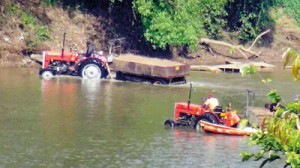
“Finding sand and other materials is the worst headache for contractors,” says the Chairman of National Construction Association of Sri Lanka, Athula Galagoda. He also says that the quality of the sand is poor.
Road Development Authority Chairman, Nihal Suriarachchi also says sourcing gravel for filling purposes is diffcult and it could affect expressway projects.
Sajeewa Chamikara of the Environment Conservation Trust suggests estimating the materials requirements and identifying ways of sourcing before projects are started.
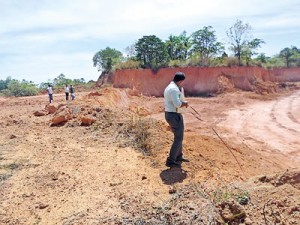
GSMB’s former chairman, Dr. N. P. Wijayananda, points out that most of the problems regarding gravel occur because the constructors or suppliers of soil and other material are looking for sources closer to construction sites. It will be cheaper to transport, but will carry a huge environmental cost.
“Find a feasible source of gravel in a central place, do the mining scientifically and transport to the construction site. Yes, the supplier will have to spend more for transport, but environmental damage will be much less,” Dr Wijayananda suggests.
The SundayTimes also asked Dr Wijayananda, what could be a possible solution. He suggests a three-pronged approach – opening up new deposits, using railways to reduce transport costs, and promote the use of sea sand.
He recalled that earlier the sand deposits at Manampitiya were opened up to meet urgent needs.
“The flow of the Mahaweli river causes sand to accumulate around the Manampitiya Bridge in Polonnaruwa, creating a flood plain around it. If we do not use this sand, they will anyway be washed to the sea. The next monsoon will replenish the sand deposits, so sand excavation in this area could be done sustainably,” Dr Wijayananda assures.
He reveals there are other sand deposits between Manampitiya and Trincomalee. But there are no proper access roads and it is not easy to transport from the sites.
“All these excavations have to be done under strict guidelines without deepening the river unnecessarily and without affecting the banks,” Dr Wijayananda said.
He also said that during his tenure at the Mines Bureau discussions were held with the railways on transporting materials, but that it was more expensive. “But if the government is willing, it can amend the rules facilitating cheaper sea sand transport by rail. I’m sure the cost of sand can be reduced by 40 percent,” he said.
Sea sand needs to be properly cleaned. “Europe extensively use sea sand for construction. We need to mechanically clean the sea sand and set standards of minimum salinity levels.”
Source – 26/03/2017, The Sunday Times , See more at – http://www.sundaytimes.lk/170326/news/building-boom-endangers-sand-and-gravel-resources-234121.html















